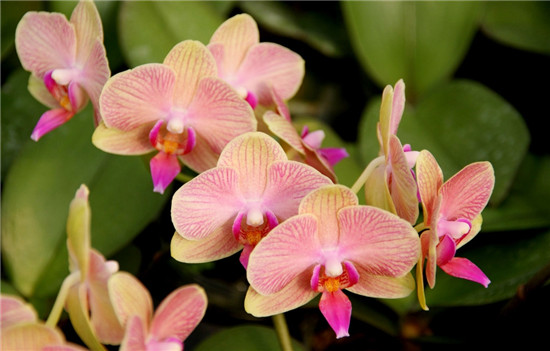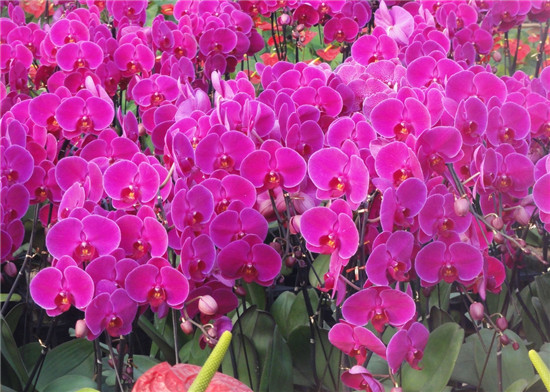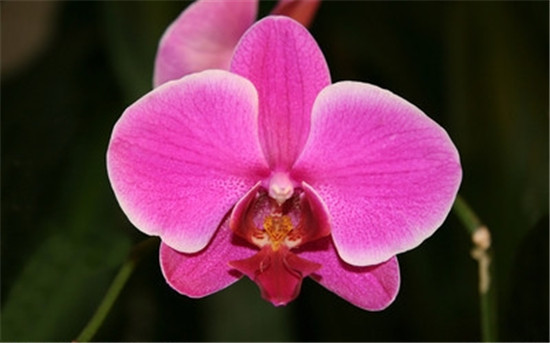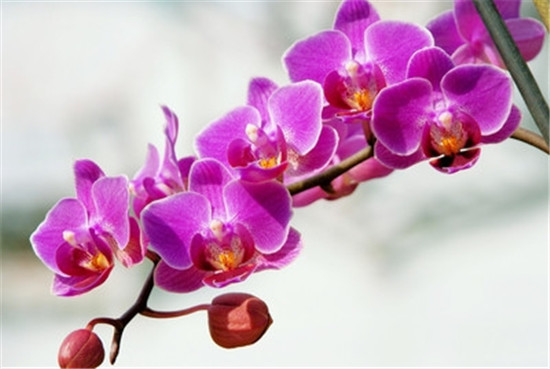How to raise butterfly orchids? cultivation methods of butterfly orchids
Phalaenopsis belongs to the genus Phalaenopsis of Orchidaceae, which is native to subtropical rain forest and is an epiphytic orchid. Next, let's take a look at the cultivation of butterfly orchids.

Phalaenopsis is a very beautiful flower, its appearance has made you can not be picky. Butterfly orchid is graceful, elegant and varied, the flower is named after the butterfly, and is widely cultivated all over the world. Although it belongs to aerial orchid, it has no false bead stem, only a very short stem at the base. The leaves are wide and thick, long oval, up to more than 50 centimeters.
There are about 100 species of Phalaenopsis, native to Eurasia, North Africa, North America and Central America. There are two famous species: two-leaf ligulate orchid, white flowers, smaller plants; green flowers, large green-white flowers, larger plant shape.
Bright color, long florescence, great appreciation value. The scientific name of Phalaenopsis is "like a butterfly orchid" in Greek. It can absorb nutrients in the air and survive and fall into the category of gas orchids. It can be said to be a large family of tropical orchids. Its plants are very peculiar, with neither stolons nor pseudobulbs.
Its emergence and development has a history. Phalaenopsis was discovered in 1750. so far, more than 70 native species have been found, most of which are found in humid Asia and are naturally distributed in low-latitude tropical islands such as Aronum, Myanmar, Indian Ocean islands, Malay Peninsula, Nanyang Islands, the Philippines and Taiwan.

Planting and maintenance of Phalaenopsis
Luminosity
The light of newly purchased bottle seedlings slowly rose to 5000Lx, from 3000-5000Lx to 5000-7000Lx, the middle seedlings of Φ 8.4cm required light intensity of 10000-3000Lx, the big seedlings of Φ 10.6cm required light intensity of 15000-18000Lx, and flower buds germinated to pedicel 10-15cm, the light increased slowly from 10000Lx to 14000Lx, and the summer management was slow. According to the light demand of different seedling stage, combined with the weather condition, the light intensity is controlled by the contraction of internal and external shading net.
Temperature
The temperature requirements of Phalaenopsis in large, middle and small days are basically the same, no more than 30 ℃, 23 ℃ for small seedlings and 20 ℃ for large seedlings at night. It requires 20-24 ℃ in daytime, 17-20 ℃ at night, 25-28 ℃ in daytime and 20-22 ℃ in night after the first flower. The temperature is heated by a heater when the temperature is low, and the fan-water curtain can be used to cool the temperature when the temperature is high.
Humidity
The best humidity requirements are more than 90% in the vegetative growth stage, 70-80% in the flowering treatment stage, and 50% after flowering. Humidity can be controlled by measures such as ventilation with water curtain and spraying humidity in ground space.

Watering
Phalaenopsis air root has a strong absorption capacity, can absorb oxygen, nutrients, water, etc., too much water will cause suffocation to the root, so Phalaenopsis watering should be seen dry with fine water irrigation, operation as far as possible not to let water stay in the leaf concave or growth point, in order to prevent mildew or infection, irrigation to the soft basin bottom hole can be overflowed. Phalaenopsis water quality is very important, especially the total hardness and iron content of water, the total hardness is lower than 50mg/L, the iron content is lower than 0.1mg/L. Tap water can be used after 1-2 days. When watering, pay attention to the alternation of dry and wet, the plant is dry and then watered, do not maintain a wet state. The water temperature is consistent with the environmental temperature of seedling growth, the earlier watering in summer morning, the better, and the best watering time is after 10:00 in winter. Check the dry and wet of the orchid before and after watering and during watering. After normal watering, some orchid plants are still dry and short of water. When the leaves are soft and sagging, we must try to improve the air humidity and must not irrigate violently every day.
Matters needing attention in Phalaenopsis Culture
1. Flowerpots: if you are careful enough, you will find that all the Phalaenopsis on the market are grown in white transparent plastic pots. It should be noted that this is not because businesses are unwilling to use good pots to reduce costs, but because the roots of Phalaenopsis need photosynthesis, so the Phalaenopsis roots that you see growing well are green, which is the result of photosynthesis. If you care at home, you can choose colorless and transparent plastic containers of the right size.

2, flower soil: generally raise Phalaenopsis will choose water moss. The quality of water moss is also important. Do not choose over-broken into powder, because water moss has strong water retention, too broken water moss will cause too much water in the root and lead to rot. Because the water moss has good water absorption, you can spread some ceramsite or orchid matrix at the bottom of the pot when raising Phalaenopsis, and then maintain it with water moss.
3. Treatment after flowering: most people receive Phalaenopsis sent by friends or buy Phalaenopsis themselves during the Spring Festival. If they are watered normally, they can usually bloom until March or April. If it is a home-raised Phalaenopsis, the flowers are still bright in mid-May.
4. Phalaenopsis likes the environment of high temperature, high humidity, ventilation and semi-shade. It is not resistant to waterlogging, cannot direct sunlight, cannot accumulate water and is afraid of cold. Wild Phalaenopsis grows mostly in humid tropical areas, so the most suitable temperature for Phalaenopsis growth is 22-28 degrees Celsius. Once the temperature is below 15 degrees Celsius, it will stop growing and die. Put Phalaenopsis in a shady and ventilated place to avoid direct sunlight. The air root of Phalaenopsis is quite many, and its root tip is green and sensitive, so it should be carefully protected and must not touch the root tip, otherwise the root will stop growing.
5. Fertilizer is essential to promote the growth of Phalaenopsis. The principle of fertilizing Phalaenopsis is to apply thin fertilizer frequently, and do not use too thick chemical fertilizer. Nitrogen and potassium fertilizer is applied in the growing period of Phalaenopsis, while phosphorus and potassium fertilizer is applied in the flowering stage, usually once every 1-2 weeks. In addition, Phalaenopsis flowering dormant period can not be fertilized, but in the early flowering and late flowering must be properly supplemented with fertilizer.
The above is the whole content of how to raise butterfly orchids and the cultivation methods of butterfly orchids. I hope this article can help you. Please continue to follow us.
Normal watering can see wet and dry, and it can usually bloom until March or April. If it is a home-grown Phalaenopsis, it will still bloom brightly until mid-May.
4. Phalaenopsis likes the environment of high temperature, high humidity, ventilation and semi-shade. It is not resistant to waterlogging, cannot direct sunlight, cannot accumulate water and is afraid of cold. Wild Phalaenopsis grows mostly in humid tropical areas, so the most suitable temperature for Phalaenopsis growth is 22-28 degrees Celsius. Once the temperature is below 15 degrees Celsius, it will stop growing and die. Put Phalaenopsis in a shady and ventilated place to avoid direct sunlight. The air root of Phalaenopsis is quite many, and its root tip is green and sensitive, so it should be carefully protected and must not touch the root tip, otherwise the root will stop growing.
5. Fertilizer is essential to promote the growth of Phalaenopsis. The principle of fertilizing Phalaenopsis is to apply thin fertilizer frequently, and do not use too thick chemical fertilizer. Nitrogen and potassium fertilizer is applied in the growing period of Phalaenopsis, while phosphorus and potassium fertilizer is applied in the flowering stage, usually once every 1-2 weeks. In addition, Phalaenopsis flowering dormant period can not be fertilized, but in the early flowering and late flowering must be properly supplemented with fertilizer.
The above is the whole content of how to raise butterfly orchids and the cultivation methods of butterfly orchids. I hope this article can help you. Please continue to follow us.
Related
- Wuhan Hospital Iron Tree Blooming Result Was Instantly Frightened by the Gardener Master
- Which variety of camellia is the most fragrant and best? Which one do you like best?
- What is the small blue coat, the breeding methods and matters needing attention of the succulent plant
- Dormancy time and maintenance management of succulent plants during dormancy
- Minas succulent how to raise, Minas succulent plant pictures
- What are the varieties of winter succulent plants
- How to raise succulent plants in twelve rolls? let's take a look at some experience of breeding twelve rolls.
- Attention should be paid to water control for succulent plants during dormant period (winter and summer)
- Watering experience of twelve rolls of succulent plants
- Techniques for fertilizing succulent plants. An article will let you know how to fertilize succulent plants.



